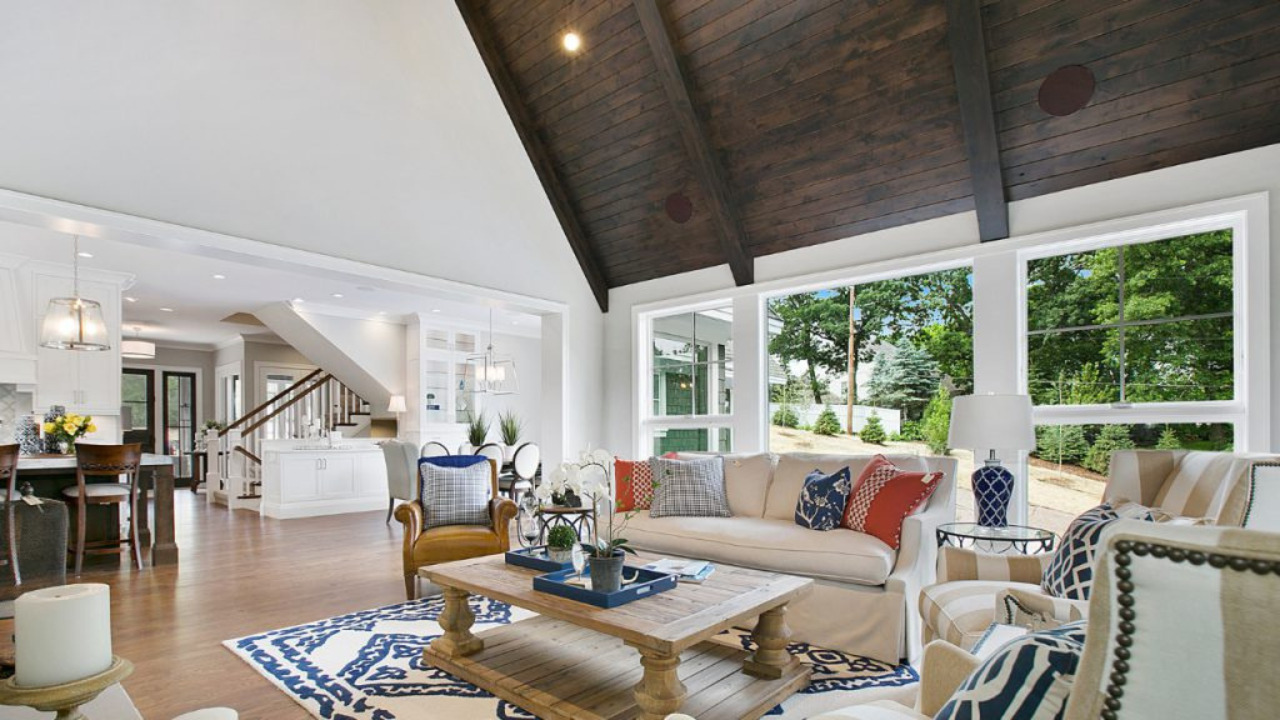The structural stability of a ceiling cannot be ignored while pick-choosing an architectural design for your living space. This sometimes necessitates the use of beam elements that serve a twofold function. The first purpose is providing structural support and the second one is improving the aesthetics of the interior.
Ceiling beams can be found in various types of ceilings such as rafter ceilings, ribbed vaulted ceilings, etc. In all these types, the beams can deliberately be kept exposed to amplify the aesthetics of the interior.
This article serves to elaborate both the functional and aesthetic purpose of ceiling beams and will also project light on ceiling beam types and different ideas that you can employ to revamp your interior.
Table of Contents
Ceiling Beams and Their Functions
A beam is a structural member that withstands the transverse loading and transfers it to the underlying supporting structures such as a wall or column. In a similar way, when we talk about ceiling beams, the basic concept remains the same.

This means that ceiling beams are also load-bearing and distributing members. They withstand the applied loads of roof, develop stresses within them and transfer the loads to underlying props or supporting structural elements.

However, the function of ceiling beams is not confined to being supporting elements. They can serve a couple of other functions. When the building interior is large and spacious, ceiling beams can efficiently bear the applied loads without requiring additional structural elements. This means that expansive construction can be made possible and open interiors can be achieved.
Another function that ceiling beams provide is that they help conceal different surface imperfections and can be installed in a pattern form such as at intervals along the roofline. This can make your interior look uncluttered and visually-appealing. In addition, ceiling beams can also hide electrical wiring, plumbing pipes or HVAC ducts to give a ceiling finish that looks elegant.

Types of Ceiling Beams

Ceiling beams entail variety particularly with respect to the material used. When beams are intentionally left exposed on the ceilings, timber is used because it helps complement the overall interior look and elevates the living space with comfort. However, the choice of ceiling beams depends upon several factors such as structural requirements, existing aesthetics and fixtures, etc.
Ceiling beams can be classified into the following types;
1) Wooden Ceiling Beams
Wooden ceiling beams are similar to rafters in rafter ceilings. However, they need not to be necessarily installed on a pitched roof. This means that even if you have a flat roof, you can install exposed wooden ceiling beams to get an augmented sense of architectural aesthetics.

Exposed wooden ceilings provide a warm, cozy and rusty look and if your house is predominantly constructed out of timer, this ceiling type can be a great choice to connect with your interior.
2) Box Wooden Ceiling Beams
Box wooden beams comprise hollow units of wood made in the form of a box shape that can be installed on the ceiling surface. The boxes can be joined together to create any pattern on the ceiling. These box beams are a great choice for structural as well as aesthetics reasons.
3) Metal Ceiling Beams

Metals beams are mostly made of iron or steel and are relatively sleek in their cross-sectional dimensions in comparison to wooden beams. They are strong, durable and can efficiently bear heavy roof loads. However, metal ceiling beams are not normally used in residential buildings and their use is mostly confined to industries or industrial-style interiors.
4) Faux Ceiling Beams

Faux beams, as the name indicates, are synthetic beams that serve primarily aesthetic purposes and have little or no contribution in withstanding roof loads. They are made to resemble timber but keeping it light in comparison to it. They can help decorate and enliven a drab living space by providing customized finishes and styles.
5) Decorative Ceiling Beams
Decorative ceiling beams serve decoration and for this purpose different materials can be used such as plaster, softwood, polyurethane, etc. These beams mostly do not have any structural function and you can customize your living space with any architectural sense you desire to adopt. Decorative beams can even be made using composite materials such as fiberglass.
Ceiling Beam Ideas
Here are a few catchy ideas to decorate your interior with ceiling beams.
1) Hang Decorative Elements

Decorative elements such as artwork or plants can be hung from ceiling beams to create an eye-catching impression. You can go with your favorite colors and a mix-and-match approach.
2) Paint the Beams

Painting the beams can be a great option because it will instantly shift focus and draw attention to your living space. The paint color should complement the interior and add an aesthetic value to it.
3) Wrap the Beams
The ceiling beams can be wrapped using artificial plants, ropes, fabric or lighting wires. Depending upon the existing building interior, you can customize it with contemporary trends using this approach.
4) Fabric Draping

Fabric draping imparts a bohemian effect and depending upon what color couples or blends well with your interior, you can go for a color fusion. This method will also create a sense of comfort and coziness within your living space.

5) Hang Decorative Lights
The idea of using decorative lights is never getting old. Colors lighting creates not just visual appeal but also aesthetic integrity since everything blends so well when subtle lights tune in.
6) Prefer a Patterned Ceiling Look
If you are installing ceiling beams primarily for structural reasons, make a good utilization out of them by arranging them to get an aesthetic pattern. You may arrange them in one direction at equal spacing or in two directions as per the look you want to have.





